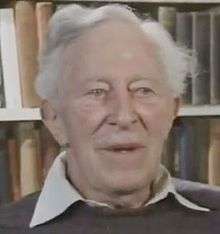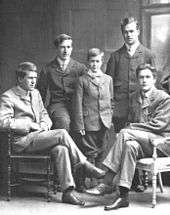A. W. Lawrence

Arnold Walter Lawrence, FBA (2 May 1900 – 31 March 1991), was a British authority on classical sculpture and architecture. He was Laurence Professor of Classical Archaeology at Cambridge University in the 1940s, and in the early 1950s in Accra he founded what later became the Ghana Museums and Monuments Board as well as the National Museum of Ghana. He was the youngest brother of T. E. Lawrence ("Lawrence of Arabia")[1] and his literary executor.
Early life

Arnold Lawrence was born at 2 Polstead Road, Oxford, on 2 May 1900, the youngest of five sons born to Thomas Chapman (who became, in 1914, Sir Thomas Chapman, 7th Baronet), an Anglo-Irish nobleman from County Westmeath, and Sarah Junner (1861–1959). The couple were unmarried but took the names "Thomas Robert Lawrence" and "Sarah Lawrence". Their second son was T. E. Lawrence who later found fame as "Lawrence of Arabia". Arnold Lawrence and he were close.[2]
The Lawrence children were brought up in Oxford by their mother who was very religious. But Arnold Lawrence expressed outspoken anti-religious views;[3] he once stated "All religion is vermin". He attended the City of Oxford High School for Boys before joining New College, Oxford, obtaining a diploma in Classical Archaeology in 1920[2] and graduating with a third in Literae Humaniores in 1921.[3] Classical archaeology was his second choice; the young A. W. Lawrence had wanted to specialise in South-American archaeology, but no British university offered a course.
Arnold Lawrence was a student at the British School at Rome in 1921 and then at the British School at Athens until 1926.[3] In 1923 Lawrence worked on the excavation of Ur which was directed by Leonard Woolley under whom T. E. Lawrence had excavated at Carchemish before the First World War. In 1925 Lawrence married Barbara Inness Thompson (1902–1986),[2] with whom he had one child, Jane Helen Thera Lawrence (1926–1978).[3]

Lawrence was the model for the statue of "Youth" (1920), sculpted by Kathleen Scott, at the Scott Polar Research Institute in Cambridge.[4]
Academic career
After T. E. Lawrence's death, A. W. Lawrence promoted his older brother's memory, collecting papers about him, and challenging what he considered any misrepresentation of his character in the press. T. E.'s enduring fame was a burden for A. W.; from his early twenties till the day he died, many people saw A. W. Lawrence primarily as the brother of someone else.
He wrote widely on the subject of Greek architecture and sculpture as well as on fortifications in west Africa.[5] In 1930 he was elected to the Laurence readership in Classical Archaeology at the University of Cambridge. In 1944 he succeeded A. J. B. Wace as Laurence Professor of Classical Archaeology at Cambridge and was elected to a Fellowship at Jesus College, Cambridge.[3] In 1951 he obtained a Leverhulme research fellowship for the study of ancient fortifications, a subject inherited from T. E. Lawrence. In 1951 he resigned from his post at Cambridge to become the Professor of Archaeology at the University College of the Gold Coast where he established the National Museum and was the Secretary and Conservator of the Monuments and Relics Committee. He resigned from these posts in 1957 after Ghana became independent and soon after settled at Pateley Bridge in Yorkshire, later moving to Bouthwaite.[3]
In the summer of 1985 Lawrence was interviewed by Julia Cave for a BBC Omnibus programme about T. E. Lawrence.[2]
In September 1985, when he and his wife could no longer drive, they moved to Langford, near Biggleswade, close to where their two grandchildren were living. Following his wife's death in November 1986, Lawrence moved to the house of a friend and fellow archaeologist, Peggy Guido (1912–1994) in Devizes, Wiltshire. There he worked on preparing a new edition of his 1935 Annotated Herodotus which was never completed. He died at 44 Long Street, Devizes, on 31 March 1991 aged 90.[3] The unfinished Herodotus material was handed over to the Bodleian Library.
Lawrence was a Fellow of the British Academy.
Books
- Lawrence, A. W. Later Greek Sculpture and its Influence. London: Jonathan Cape; New York: Harcourt Brace, 1927.
- Lawrence, A. W. Classical Sculpture – Its History from the Earliest Times to the Death of Constantine. London: Jonathan Cape, 1929.
- Lawrence, A. W., ed. Narratives of the Discovery of America. London: Jonathan Cape, 1931.
- Lawrence, A. W. Herodotus, Rawlinson's Translation Revised and Annotated. London: Nonesuch Press, 1935.
- Lawrence, A. W., ed. T.E. Lawrence by His Friends. London: Jonathan Cape; Garden City, NY: Doubleday, 1937.
- Lawrence, A. W. Greek Architecture. London: Penguin; New Haven: Yale University Press, 1957; 2nd ed, 1967 (later editions revised by others).
- Lawrence, A. W., ed. Letters to T.E. Lawrence. London: Jonathan Cape, 1962.
- Lawrence, A. W. Trade Castles and Forts of West Africa. London: Jonathan Cape; Palo Alto, CA: Stanford University Press, 1963.
- Lawrence, A. W. Greek and Roman Sculpture. London: Jonathan Cape, 1972.
- Lawrence, A. W. Greek Aims in Fortification. Oxford: Clarendon Press, 1979.
References
- ↑ Lundy, Darryl. "Lawrence Family". The Peerage. Retrieved 12 September 2016.
- 1 2 3 4 "Biography of Lawrence at Dictionary of Art Historians". Archived from the original on 7 November 2009. Retrieved 17 October 2009.
- 1 2 3 4 5 6 7 [R. M. Cook, 'Lawrence, Arnold Walter (1900–1991)', Oxford Dictionary of National Biography, Oxford University Press, September 2004; online edn, May 2009 accessed 17 October 2009
- ↑ SPRI
- ↑ "Lawrence on the Yale University Press website". Retrieved 17 October 2009.
External links
- Papers of T. E. Lawrence and A. W. Lawrence held at The Bodleian Library, University of Oxford
- Biography of Lawrence at Dictionary of Art Historians
- Lundy, Darryl. "Lawrence Family". The Peerage.
- English translation of an article about A. W. Lawrence in the Dutch daily NRC Handelsblad, 15 August 1992
| Academic offices | ||
|---|---|---|
| Preceded by A.J.B. Wace |
Laurence Professor of Classical Archaeology Cambridge University 1944–1951 |
Succeeded by Jocelyn Mary Catherine Toynbee |
